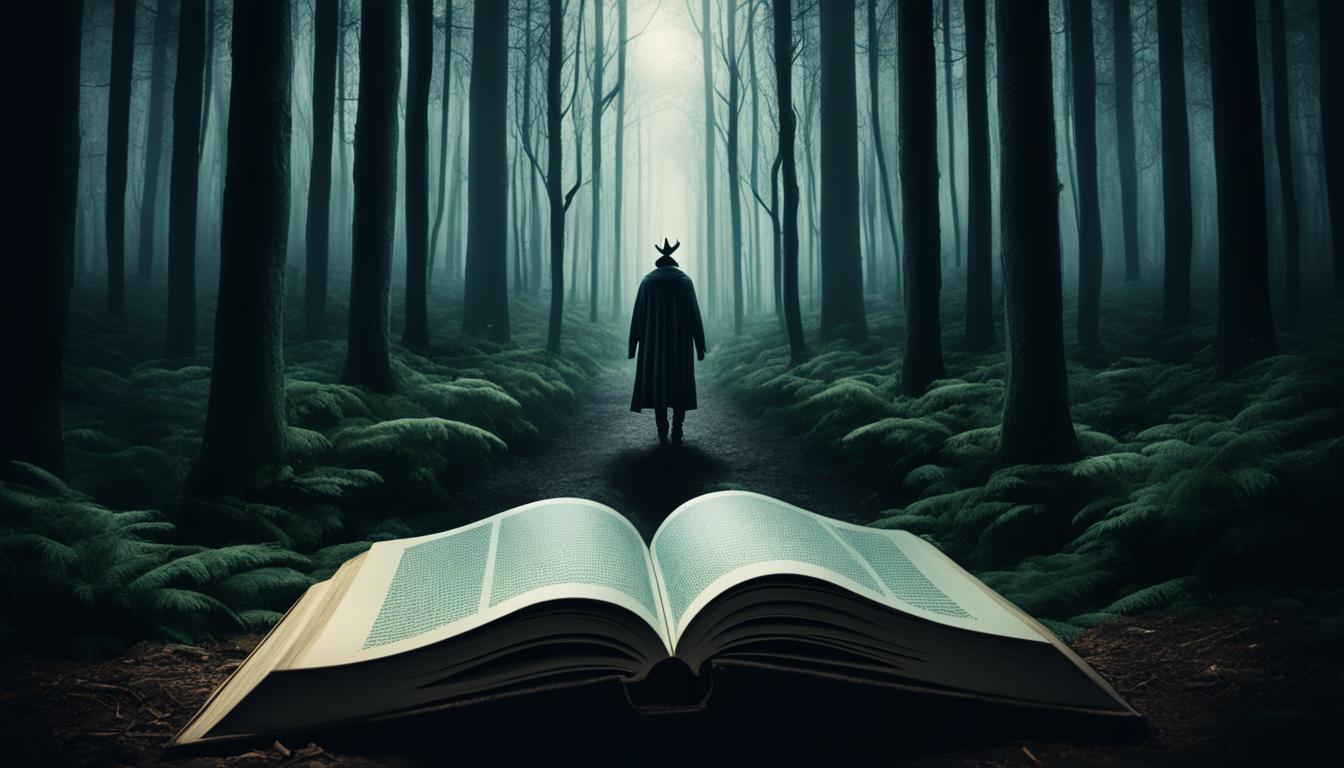Stephen King is widely regarded as one of the most influential horror writers of our time, and “The Boogeyman” is one of his most gripping short stories. If you’re looking for a spine-chilling read, this story is a must-try.
In this article, we’ll delve into the world of “The Boogeyman,” exploring its plot, themes, characters, and the impact it has had on readers. Join us on this journey as we analyze Stephen King’s writing style and discuss why this story remains a favorite among horror enthusiasts.
Key Takeaways:
- Stephen King’s “The Boogeyman” is a short story that is guaranteed to send chills down your spine.
- This story explores themes of grief, guilt, and the supernatural.
- King’s use of descriptive language and foreshadowing adds to the eeriness of the story.
- “The Boogeyman” has had a lasting impact on readers and continues to be a favorite among horror enthusiasts.
- For readers who enjoy “The Boogeyman,” we recommend checking out other notable works by Stephen King, such as “It” and “The Shining.”
The Background of “The Boogeyman”
Stephen King is a prolific American author who has made a name for himself in the horror genre. With over 60 published novels and numerous short stories, King’s work is revered by many for its ability to terrify and captivate readers. “The Boogeyman” is a notable addition to King’s body of work as a short story that first appeared in his collection “Night Shift” in 1978.
“The Boogeyman” stands out among King’s other short stories because of its direct and haunting storytelling. It is considered a prime example of King’s mastery of horror fiction and a testament to his ability to convey terror on the page in just a few short pages.
As a short story, “The Boogeyman” exemplifies King’s skill in building a suspenseful narrative within a limited space and creating a sense of dread that lingers long after the final page is turned. Its impact is felt not only within the realm of horror literature but in popular culture as well, inspiring films, TV adaptations, and other media.
Plot Summary of “The Boogeyman”
“The Boogeyman” by Stephen King is a short horror story that follows the protagonist, Lester Billings, as he reveals his tragic past to a psychiatrist. Lester’s children have all been murdered by the boogeyman and he believes the same evil creature is coming for him.
As Lester shares his story, readers learn about the deaths of his three children and the haunting presence of the boogeyman in their lives. The story culminates in a terrifying conclusion that leaves readers questioning the reality of the events that transpired.
The story’s major themes include the power of fear and the darkness that lies beneath the surface of everyday life. The use of suspenseful foreshadowing and chilling imagery creates a tense and eerie atmosphere throughout the narrative.
Overall, “The Boogeyman” is a haunting and impactful horror story that continues to captivate and terrify readers to this day.
Analysis of the Characters in “The Boogeyman”
As with many of Stephen King’s stories, “The Boogeyman” relies heavily on its characters to drive the narrative forward. The main character Lester Billings serves as the protagonist and is the first individual to introduce the titular character to the audience. Throughout the story, the audience is shown how Lester’s psyche is gradually destroyed by the loss of his children and how this ultimately leads to his death.
Lester’s fear is the central theme of the story, as his terror evolves from the death of his children to the realization that the Boogeyman is after him. The Boogeyman itself is a monstrous presence that seems to reside in the closet and is never fully described, but it is suggested that this nightmare figure has a long and dark history with Lester as a consequence of his past mistakes.
The secondary characters in the story, including Lester’s wife and his psychiatrist, also play significant roles in the progression of the narrative. Lester’s wife’s lack of interest in her husband’s concerns and complaints diminishes his mental well-being. The psychiatrist’s analysis of Lester’s condition, while helpful, fails to properly diagnose the severity of his mental and emotional disturbance and its connection to the Boogeyman.
In conclusion, the characters in “The Boogeyman” are complex and richly developed. King has expertly crafted a story that showcases the psychological struggles of ordinary people in extraordinary circumstances. The audience is taken on a journey as we witness the unraveling of Lester’s mind, and the impact that this has on all those around him.

Themes and Symbolism in “The Boogeyman”
Stephen King weaves together various themes and symbolism in “The Boogeyman” to create a chilling and suspenseful atmosphere that leaves readers on the edge of their seats.
The Theme of Grief and Loss
One of the primary themes in “The Boogeyman” is that of grief and loss. Throughout the story, we see the protagonist struggling to come to terms with the deaths of his three children. Their loss haunts him and affects his relationships with others, including his wife and therapist. The Boogeyman, in this regard, can be seen as a manifestation of the protagonist’s overwhelming grief and guilt.
The Symbolism of Doors
Doors are a prominent symbol in “The Boogeyman.” They represent both safety and danger, as well as the thin line between the two. The protagonist’s fear of doors and their potential danger is an integral part of the story’s suspenseful and foreboding atmosphere.
The Theme of Mental Health
Another significant theme in “The Boogeyman” is that of mental health. The protagonist’s struggle with grief and guilt manifests itself in his intense phobia of the Boogeyman and doorways. The story can be seen as a commentary on the debilitating effects of untreated mental health issues.
Through his use of themes and symbolism, King creates a story that is not only terrifying but also thought-provoking. “The Boogeyman” remains a cornerstone of the horror genre and a testament to King’s skill as a writer.
Writing Style and Techniques in “The Boogeyman”
Stephen King’s writing style in “The Boogeyman” is remarkable for its ability to create a palpable sense of tension and suspense. He employs various techniques to evoke a sense of fear and unease in the reader.
Descriptive Language
King’s use of descriptive language is one of his most effective tools in building atmosphere. He paints vivid and often grotesque images that tap into the reader’s deepest fears and anxieties. For example, “The Boogeyman” is rich with descriptions of grotesque entities that lurk in the shadows, waiting to strike.
Pacing
King is a master of pacing, and “The Boogeyman” is no exception. He carefully controls the speed at which the story unfolds, gradually building tension and suspense. He achieves this by alternating periods of slow, introspective reflection with moments of sudden, shocking violence.
Foreshadowing
Throughout “The Boogeyman,” King employs foreshadowing to create a sense of dread, hinting at the horrors to come. For example, the story’s opening line is “I came to you because I want to tell my story,” immediately setting a tone of foreboding and uneasiness.
Overall, King’s writing style and techniques in “The Boogeyman” demonstrate his mastery of the horror genre and his ability to craft a truly terrifying tale. His use of descriptive language, pacing, and foreshadowing all combine to create a palpable sense of fear and unease in the reader.
Reception and Impact of “The Boogeyman”
Upon its publication in 1973, “The Boogeyman” received critical acclaim and solidified Stephen King’s place as a master of horror. The story was notable for its unsettling atmosphere, psychological terror, and unexpected ending. King’s adept use of suspenseful storytelling left readers on the edge of their seats, eager to turn each page with trepidation.
In the years since its release, “The Boogeyman” has continued to leave an impact on readers and the horror genre as a whole. It has been reprinted numerous times and adapted for both film and radio.
Many readers have praised the story’s ability to tap into universal fears and anxieties, leaving lasting impressions that stay with them long after reading. Critics have lauded King’s masterful storytelling and the skillful construction of the plot and characters.
Overall, the lasting reception and impact of “The Boogeyman” speaks to its enduring power as a horror classic and reinforces Stephen King’s reputation as a prolific and talented author.
Recommended Reading for Stephen King Fans
For readers who enjoyed “The Boogeyman” by Stephen King, there are many other works by the horror master that are worth exploring. Here are some recommended reads:
1. “The Shining”
Considered one of King’s greatest works, “The Shining” follows struggling writer Jack Torrance and his family as they become caretakers of the eerie Overlook Hotel. As the supernatural forces of the hotel begin to close in on them, Jack’s grip on reality starts to loosen.
2. “Salem’s Lot”
This chilling tale of a small town overrun by vampires is sure to keep readers up at night. As the undead spread throughout Salem’s Lot, a small band of survivors must fight for their lives against an ancient evil.
3. “Night Shift”
 This collection of short stories showcases King’s range as a writer and includes “The Boogeyman” as well as other classics like “Children of the Corn” and “The Lawnmower Man.”
This collection of short stories showcases King’s range as a writer and includes “The Boogeyman” as well as other classics like “Children of the Corn” and “The Lawnmower Man.”
4. “Carrie”
King’s first published novel tells the story of Carrie White, a troubled teenage girl with telekinetic powers who is relentlessly bullied by her classmates. When she is pushed too far, Carrie unleashes her deadly powers on her tormentors.
These are just a few of the many thrilling works by Stephen King that fans of “The Boogeyman” are sure to love.
Conclusion
In conclusion, “The Boogeyman” by Stephen King is a masterful piece of horror fiction that has enthralled readers for decades. King’s expert use of descriptive language, suspense-building techniques, and literary devices creates an eerie and unsettling atmosphere that lingers long after the story ends. The characters are well-developed, their motivations and fears explored in depth, and their transformations throughout the narrative add to the story’s impact.
Overall, “The Boogeyman” is a must-read for fans of horror fiction, as well as those who appreciate skilled storytelling and intricate plotlines. Its impact can be seen in the enduring popularity of Stephen King’s body of work and its continued influence on the horror genre.
If you enjoyed “The Boogeyman,” we recommend exploring other works by Stephen King, such as “Carrie,” “The Shining,” and “It.” These novels and short stories share similar themes and writing styles and are sure to captivate readers looking for more of King’s trademark blend of suspense, terror, and emotional depth.
FAQ
What is "The Boogeyman" by Stephen King about?
“The Boogeyman” is a chilling short story written by Stephen King. It revolves around a man named Lester Billings who is haunted by the fear that his children were killed by the boogeyman. The story delves into the psychological torment and horror experienced by the protagonist as he confronts this malevolent entity.
Is "The Boogeyman" a part of Stephen King’s larger body of work?
Yes, “The Boogeyman” is a significant part of Stephen King’s extensive repertoire of horror literature. It was first published in 1973 and has since become one of his most well-known and influential short stories.
What are the main themes and symbolism in "The Boogeyman"?
“The Boogeyman” explores various themes related to fear, guilt, and the fear of loss. The boogeyman itself symbolizes the darkest aspects of human nature and the supernatural forces that can prey on our deepest fears.
How does Stephen King build suspense and create an eerie atmosphere in "The Boogeyman"?
Stephen King uses various writing techniques to create suspense and an eerie atmosphere in “The Boogeyman.” He employs vivid and descriptive language to set the scene, masterful pacing to gradually build tension, and foreshadowing to hint at the impending horrors.
What has been the reception and impact of "The Boogeyman" over the years?
“The Boogeyman” has received widespread acclaim from readers and critics alike. It has become a classic example of Stephen King’s ability to tap into universal fears and emotions. The story’s impact can be seen in its enduring popularity and its influence on the horror genre as a whole.
Are there any other works by Stephen King that fans of "The Boogeyman" might enjoy?
Absolutely! Stephen King has written a vast collection of novels and short stories, many of which explore similar themes and showcase his distinctive writing style. Some recommended readings for fans of “The Boogeyman” include “It,” “The Shining,” “Pet Sematary,” “Carrie,” and “Misery.”



